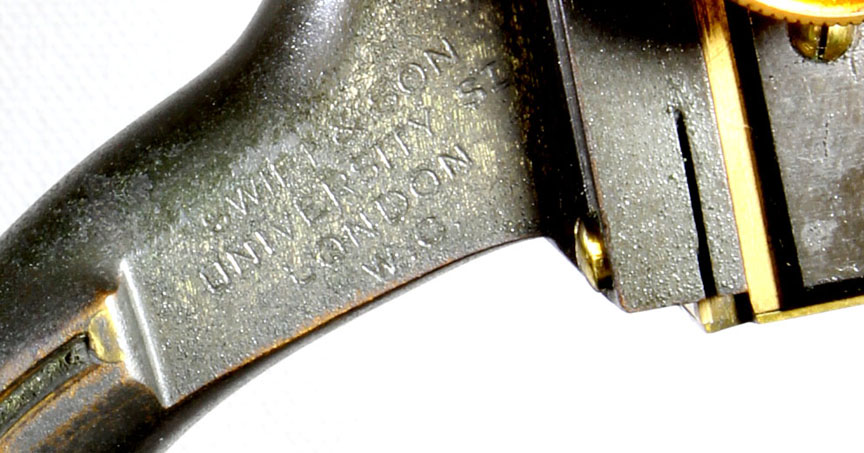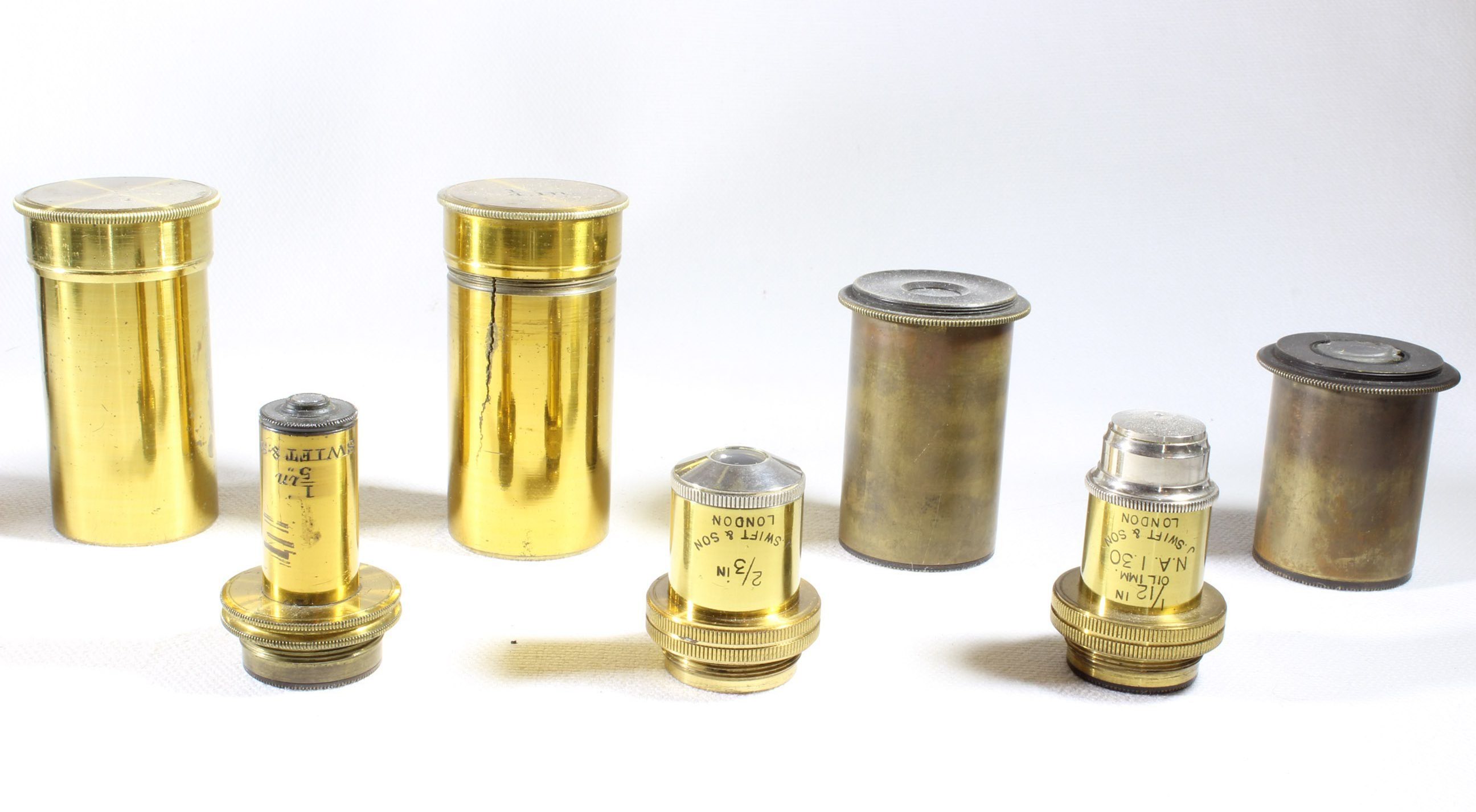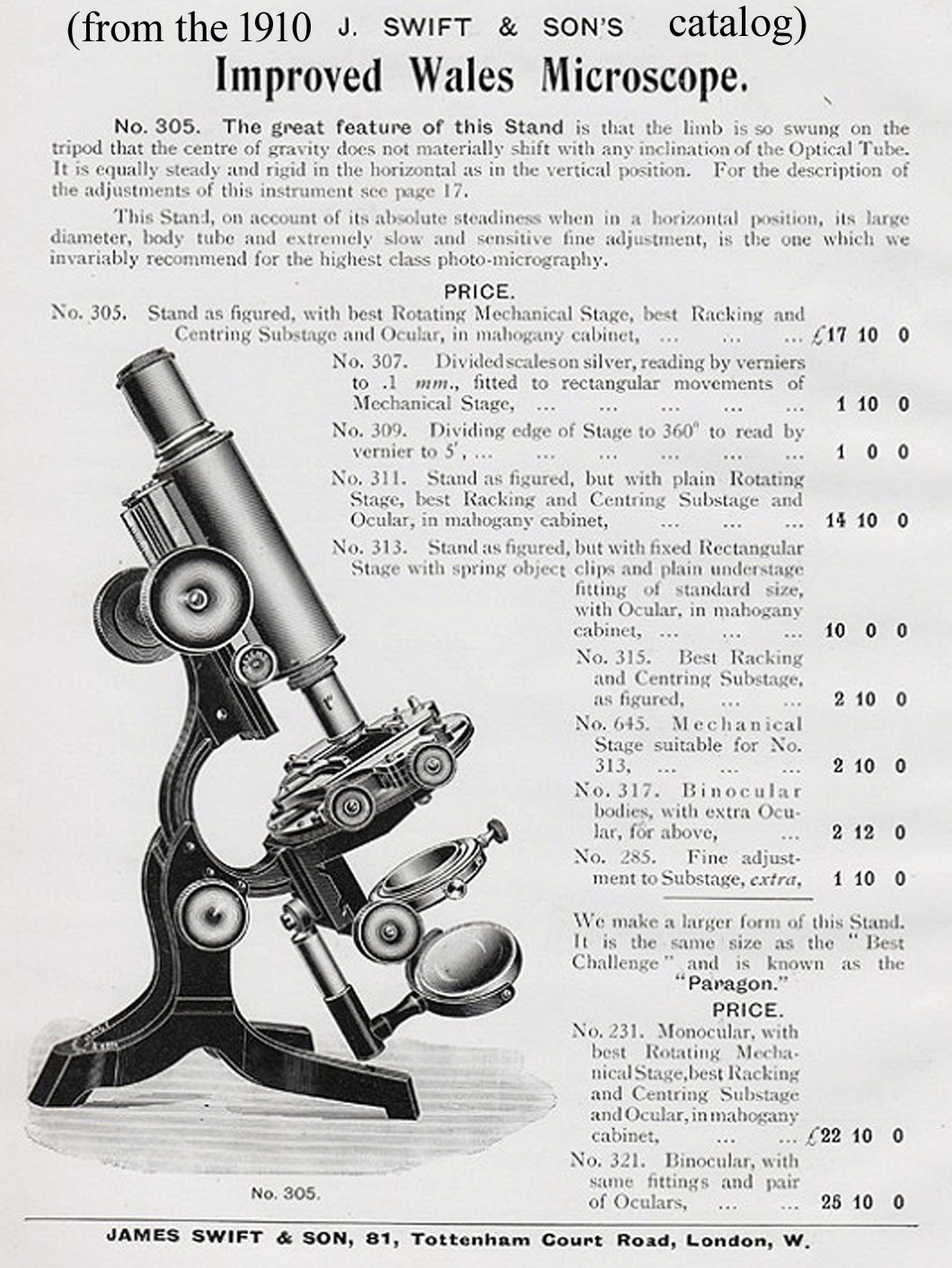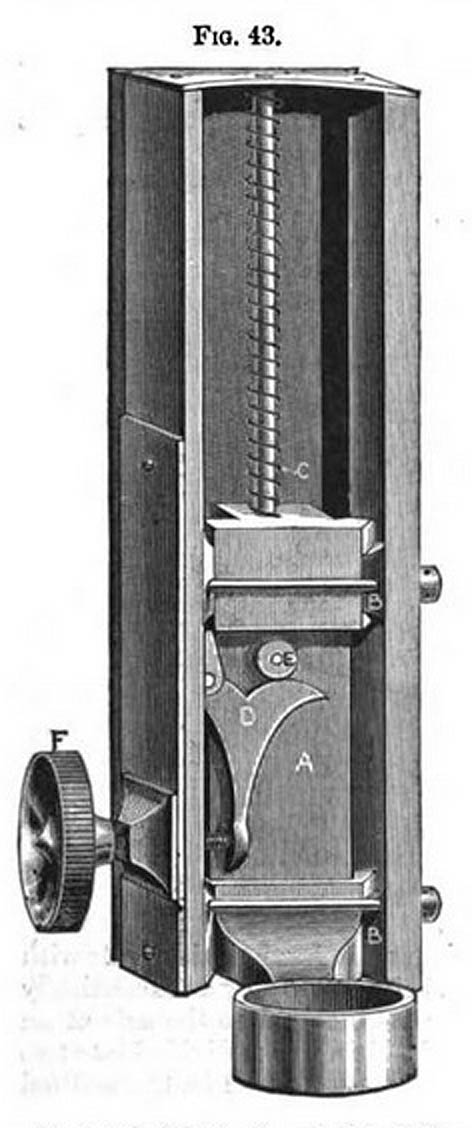MICROSCOPE-ANTIQUES.COM © 2013-15.
MODEL: SWIFT IMPROVED WALES MICROSCOPE NO. 313'
DATE: 1881-1912 c.1881
MAKER: JAMES SWIFT & SON
SIGNED: SWIFT & SON, UNIVERSITY SD, LONDON W.C.
SERIAL NUMBER: NONE
DESCRIPTION:
 This Wale limb microscope, which is well made, is supported by a special foot in which the grooved limb glides
for inclination. The microscope can be clamped at any degree of inclination via a knurled knob on the right side
of the foot. The foot is actually composed of two parts that grasp the groove between them. This simplified model of Swift Wales Limb has a receptacle under the stage to accept
accessories; it has a dome shaped revolving wheel of apertures at its top nearest the stage, which the 1881 volume of the JRMS referred to as a 'calotte diaphragm'. The gimbaled planoconcave mirror rides up and down the tailpiece on a sleeve; the tailpiece
itself can swing over to 90 degrees, but not above the stage. The coarse focus is the Swift design of 'spiral' or diagonal rack and pinion;
the fine focus is the patented Swift vertical long lever fine adjustment controlled from the side below the coarse. There is a single drawtube. The fixed stage is round, with a glass surface and two stage clips.
This Wale limb microscope, which is well made, is supported by a special foot in which the grooved limb glides
for inclination. The microscope can be clamped at any degree of inclination via a knurled knob on the right side
of the foot. The foot is actually composed of two parts that grasp the groove between them. This simplified model of Swift Wales Limb has a receptacle under the stage to accept
accessories; it has a dome shaped revolving wheel of apertures at its top nearest the stage, which the 1881 volume of the JRMS referred to as a 'calotte diaphragm'. The gimbaled planoconcave mirror rides up and down the tailpiece on a sleeve; the tailpiece
itself can swing over to 90 degrees, but not above the stage. The coarse focus is the Swift design of 'spiral' or diagonal rack and pinion;
the fine focus is the patented Swift vertical long lever fine adjustment controlled from the side below the coarse. There is a single drawtube. The fixed stage is round, with a glass surface and two stage clips.
 Accessories include the box, two unsigned Swift oculars, and three signed Swift objectives of 2/3 inch, 1/5 inch and 1/12 inch focal lengths. The 1/12th is an oil immersion lens. The 2/3 and 1/12 are of more
recent manufacture than the 1/5 inch which is of the older design.
Accessories include the box, two unsigned Swift oculars, and three signed Swift objectives of 2/3 inch, 1/5 inch and 1/12 inch focal lengths. The 1/12th is an oil immersion lens. The 2/3 and 1/12 are of more
recent manufacture than the 1/5 inch which is of the older design.
HISTORY OF THE SWIFT 'WALES LIMB' MICROSCOPES AND THE SIDE FINE ADJUSTMENT
 The American microscope maker George Wale invented the grooved inclination system which bears his name about 1878. The first illustration of it that I am aware of was published in the Young Scientist. It was also published in the American Journal of Microscopy and Popular Science, Vol 4, No 4, Page 93 (1879) and also in the J. of the RMS, vol II, p624 in the same year. The latter illustration, although clearly showing a portion of the Wale limb, accompanied a brief article about rotating stage clips for Wale's stage; the first article in the RMS Journal fully illustrating the Wales New Working microscope was in 1880, in the Journal of the RMS, Vol 3, page 1046.
Wale's first microscopes using this method of inclination were called his 'New Working Microscope'
The American microscope maker George Wale invented the grooved inclination system which bears his name about 1878. The first illustration of it that I am aware of was published in the Young Scientist. It was also published in the American Journal of Microscopy and Popular Science, Vol 4, No 4, Page 93 (1879) and also in the J. of the RMS, vol II, p624 in the same year. The latter illustration, although clearly showing a portion of the Wale limb, accompanied a brief article about rotating stage clips for Wale's stage; the first article in the RMS Journal fully illustrating the Wales New Working microscope was in 1880, in the Journal of the RMS, Vol 3, page 1046.
Wale's first microscopes using this method of inclination were called his 'New Working Microscope'
In 1881, the JRMS featured an image of the Swift microscope seen above, and showing that the English makers were swift to adopt this design! Swift was so impressed with this design, that, according to
Davis as of 1889,
they intended to feature it as their primary type of limb; it was therefore available in many models up to and
including Swift's biggest Wale limb microscope he called the Paragon
. The advantage of the Wale limb is that the center of gravity, and therefore the stability of the microscope did not change regardless of the angle of inclination. Swift's version is an improvement over Wale's design, because in Wale's case the limb groove was just part of an iron casting; in Swift's examples
this groove was machined into the oxidized brass limb for smoother operation. This method of inclination was also incorporated by many other makers including Schrauer, Bausch & Lomb (in their 'American Concentric Microscope'), Watson & Sons, and the ultimate version, the Wenham Radial
Microscope by Ross. Although initially intended simply to provide stability during inclination, the principal was applied to allow very oblique illumination. The Ross Radial microscope provided many adjustments to provide virtually any kind of oblique illumination. Similar elaborate radial
arrangements were also made by Beck, Watson, and many other makers.
 Another feature of this microscope is Swift's invention of a
vertical long-lever fine adjustment, controlled from the side of the microscope. Control of the fine focus from the side
rather than the top of the limb (as was customary before), later became a standard feature of the modern microscope.
The idea of fine focus control from the side was probably first used on Powell and Lealand's early stands, although they soon
changed its location to the top of the arm because their original mechanism, was prone to malfunction. It was Swift in England, and Berger in Germany who revived this idea,
Berger's design being far superior because, among other reasons, it is much less likely to wear out in prolonged use than a lever.
Another feature of this microscope is Swift's invention of a
vertical long-lever fine adjustment, controlled from the side of the microscope. Control of the fine focus from the side
rather than the top of the limb (as was customary before), later became a standard feature of the modern microscope.
The idea of fine focus control from the side was probably first used on Powell and Lealand's early stands, although they soon
changed its location to the top of the arm because their original mechanism, was prone to malfunction. It was Swift in England, and Berger in Germany who revived this idea,
Berger's design being far superior because, among other reasons, it is much less likely to wear out in prolonged use than a lever.
It appears that the Swift Wales
Microscopes of the type pictured above here were offered from no later than 1881* until at least 1910. In 1883 Swift offered their Radial Inclining Microscope
with a Wale limb. In 1914 an improved version of Wale limb was offered on the elaborate Swift Photographic Petrological Microscope
. This tradition continued in the even later (c. 1925), and equally elaborate,Symposium
Model.
*See the JRMS, Series II, volume I, 1881, pages 296-298. I would like to thank Allan Wissner for helping me more accurately date this instrument and its first production year.
 This Wale limb microscope, which is well made, is supported by a special foot in which the grooved limb glides
for inclination. The microscope can be clamped at any degree of inclination via a knurled knob on the right side
of the foot. The foot is actually composed of two parts that grasp the groove between them. This simplified model of Swift Wales Limb has a receptacle under the stage to accept
accessories; it has a dome shaped revolving wheel of apertures at its top nearest the stage, which the 1881 volume of the JRMS referred to as a 'calotte diaphragm'. The gimbaled planoconcave mirror rides up and down the tailpiece on a sleeve; the tailpiece
itself can swing over to 90 degrees, but not above the stage. The coarse focus is the Swift design of 'spiral' or diagonal rack and pinion;
the fine focus is the patented Swift vertical long lever fine adjustment controlled from the side below the coarse. There is a single drawtube. The fixed stage is round, with a glass surface and two stage clips.
This Wale limb microscope, which is well made, is supported by a special foot in which the grooved limb glides
for inclination. The microscope can be clamped at any degree of inclination via a knurled knob on the right side
of the foot. The foot is actually composed of two parts that grasp the groove between them. This simplified model of Swift Wales Limb has a receptacle under the stage to accept
accessories; it has a dome shaped revolving wheel of apertures at its top nearest the stage, which the 1881 volume of the JRMS referred to as a 'calotte diaphragm'. The gimbaled planoconcave mirror rides up and down the tailpiece on a sleeve; the tailpiece
itself can swing over to 90 degrees, but not above the stage. The coarse focus is the Swift design of 'spiral' or diagonal rack and pinion;
the fine focus is the patented Swift vertical long lever fine adjustment controlled from the side below the coarse. There is a single drawtube. The fixed stage is round, with a glass surface and two stage clips.
 Accessories include the box, two unsigned Swift oculars, and three signed Swift objectives of 2/3 inch, 1/5 inch and 1/12 inch focal lengths. The 1/12th is an oil immersion lens. The 2/3 and 1/12 are of more
recent manufacture than the 1/5 inch which is of the older design.
Accessories include the box, two unsigned Swift oculars, and three signed Swift objectives of 2/3 inch, 1/5 inch and 1/12 inch focal lengths. The 1/12th is an oil immersion lens. The 2/3 and 1/12 are of more
recent manufacture than the 1/5 inch which is of the older design.
 The American microscope maker George Wale invented the grooved inclination system which bears his name about 1878. The first illustration of it that I am aware of was published in the Young Scientist. It was also published in the American Journal of Microscopy and Popular Science, Vol 4, No 4, Page 93 (1879) and also in the J. of the RMS, vol II, p624 in the same year. The latter illustration, although clearly showing a portion of the Wale limb, accompanied a brief article about rotating stage clips for Wale's stage; the first article in the RMS Journal fully illustrating the Wales New Working microscope was in 1880, in the Journal of the RMS, Vol 3, page 1046.
Wale's first microscopes using this method of inclination were called his 'New Working Microscope'
The American microscope maker George Wale invented the grooved inclination system which bears his name about 1878. The first illustration of it that I am aware of was published in the Young Scientist. It was also published in the American Journal of Microscopy and Popular Science, Vol 4, No 4, Page 93 (1879) and also in the J. of the RMS, vol II, p624 in the same year. The latter illustration, although clearly showing a portion of the Wale limb, accompanied a brief article about rotating stage clips for Wale's stage; the first article in the RMS Journal fully illustrating the Wales New Working microscope was in 1880, in the Journal of the RMS, Vol 3, page 1046.
Wale's first microscopes using this method of inclination were called his 'New Working Microscope'  Another feature of this microscope is Swift's invention of a
vertical long-lever fine adjustment, controlled from the side of the microscope. Control of the fine focus from the side
rather than the top of the limb (as was customary before), later became a standard feature of the modern microscope.
The idea of fine focus control from the side was probably first used on Powell and Lealand's early stands, although they soon
changed its location to the top of the arm because their original mechanism, was prone to malfunction. It was Swift in England, and Berger in Germany who revived this idea,
Berger's design being far superior because, among other reasons, it is much less likely to wear out in prolonged use than a lever.
Another feature of this microscope is Swift's invention of a
vertical long-lever fine adjustment, controlled from the side of the microscope. Control of the fine focus from the side
rather than the top of the limb (as was customary before), later became a standard feature of the modern microscope.
The idea of fine focus control from the side was probably first used on Powell and Lealand's early stands, although they soon
changed its location to the top of the arm because their original mechanism, was prone to malfunction. It was Swift in England, and Berger in Germany who revived this idea,
Berger's design being far superior because, among other reasons, it is much less likely to wear out in prolonged use than a lever.